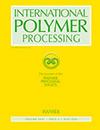水下聚合物挤压造粒机中颗粒团聚分析:数值模拟研究
IF 1.9
4区 工程技术
Q4 ENGINEERING, CHEMICAL
引用次数: 0
摘要
利用水下模面造粒机生产热塑性塑料颗粒是热塑性塑料复合工业中普遍采用的一种工艺。该工艺的一个主要挑战是颗粒团聚,当聚合物柔韧或在加热下容易变形时就会发生颗粒团聚。为了解决这个问题,使用ANSYS Fluent中的三维(3D)计算流体动力学(CFD)计算,对聚合物的非牛顿流动、加热油的湍流流动和通过模具的传热进行了建模。通过比较两个模型对温度和压力的预测(使用滑动法和不使用滑动法)与工业规模制粒机的实验测量结果,验证了计算模型的有效性,结果表明,温度和压力的最大误差分别为3%和16%。水下模制球机的效率通常是根据它产生球团的速率来评估的。操作参数的微小变化,如聚合物的入口质量流量和温度、加热油的温度和水温,都会极大地影响最终产品的质量。首先,给出了压力、速度和温度的等高线,以了解它们对球团团聚的影响。然而,为了更具体地将颗粒质量(即颗粒团聚率)与输入条件联系起来,该研究开发了一个名为颗粒团聚数(PAN)的无量纲参数,该参数是另外三个无量纲数(雷诺数、欧拉数和无量纲温度)的非线性函数。在出口和进口的PAN值显示与实验测量的颗粒团块有很好的相关性,从而证明PAN不仅在区分好和坏颗粒质量方面有用,而且还可以先验地确定导致商业造粒机中颗粒团块减少的适当操作条件。本文章由计算机程序翻译,如有差异,请以英文原文为准。
Analyzing pellet agglomeration in underwater polymer extrusion pelletizers: a numerical simulation study
Abstract The production of thermoplastic pellets using underwater die-face pelletizers is a widespread process in the thermoplastics compounding industry. One major challenge in this process is pellet agglomeration, which occurs when the polymer is pliable or easily deformed under heat. To tackle this issue, the non-Newtonian flow of a polymer, along with the turbulent flow of heating oil and heat transfer through the die, are modeled using three-dimensional (3D) computational fluid dynamics (CFD) calculations in ANSYS Fluent. The computational model is validated by comparing its predictions of temperature and pressure using two models with and without a slip method, to experimental measurements from an industrial-scale pelletizer, resulting in a maximum error of <3 % for temperature and <16 % for pressure. The efficiency of the underwater die pelletizer is typically evaluated based on the rate at which it produces pellets. Minor variations in operational parameters, such as the inlet mass flow rate and temperature of the polymer, the temperature of the heating oil, and the water temperature, can greatly affect the quality of the final product. Firstly, contours of pressure, velocity and temperature are presented to understand their impact on pellet agglomeration. However, to more specifically link pellet quality, i.e. pellet agglomeration rate, to the input conditions, the study develops a non-dimensional parameter called the pellet agglomeration number (PAN), as a non-linear function of three other non-dimensional numbers: Reynolds number, Euler number, and a non-dimensional temperature. The values of PAN at the exit and inlet are shown to correlate well with the experimentally measured pellet agglomerations, thereby demonstrating the usefulness of PAN in not only differentiating between good and bad pellet quality but also determining apriori the appropriate operating conditions leading to fewer pellet agglomerations in commercial pelletizers.
求助全文
通过发布文献求助,成功后即可免费获取论文全文。
去求助
来源期刊

International Polymer Processing
工程技术-高分子科学
CiteScore
2.20
自引率
7.70%
发文量
62
审稿时长
6 months
期刊介绍:
International Polymer Processing offers original research contributions, invited review papers and recent technological developments in processing thermoplastics, thermosets, elastomers and fibers as well as polymer reaction engineering. For more than 25 years International Polymer Processing, the journal of the Polymer Processing Society, provides strictly peer-reviewed, high-quality articles and rapid communications from the leading experts around the world.
 求助内容:
求助内容: 应助结果提醒方式:
应助结果提醒方式:


